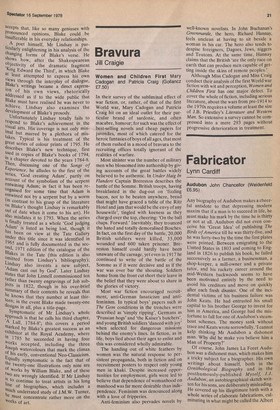Bravura
Jill Craigie
Women and Children First Mary Cadogan and Patricia Craig (Gollancz £7.50) In their survey of the subliminal effect of war fiction, or, rather, of that of the first World war, Mary Cadogan and Patricia Craig hit on an ideal outlet for their particular brand of sardonic, and often macabre, humour; for such was the effect of best-selling novels and cheap papers for juveniles, most of which catered for the heroic fantasies of boys of all ages, that most of them rushed in a mood of bravura to the recruiting offices totally ignorant of the realities of warfare.
Most sinister was the number of military men who blossomed into authorship by giving accounts of the great battles widely believed to be authentic. In Under Haig In Flanders Captain Brereston describes the battle of the Somme. British troops, having breakfasted in the dug-out on 'fizzling bacon, not to be beaten anywhere, bread that might have graced a table of the Ritz Hotel and jam that would be the envy of any housewife', tingled with keeness as they charged over the top, cheering: 'On the ball chaps. Forward.' Inevitably, they trounced the hated and totally demoralised Bosches. In fact, on the first day of the battle, 20,000 British soldiers were killed, 35,000 wounded and 600 taken prisoner. Brereston himself could hardly have been unaware of the carnage, yet even in 1917 he continued to write of the battle of the Somme as if it were decisive and as if the war was over bar the shouting. Soldiers home from the front cut short their leave in the belief that they were about to share in the glories of victory.
Most war fiction encouraged recruitment, anti-German fanaticism and antifeminism. In typical boys' papers such as The Gem conditions in the trenches were described as 'simply ripping', Germans as 'Prussian hogs' and 'the Kaiser's butchers', and young British soldiers 'danced with joy' when selected for dangerous missions behind the enemy's lines. In fiction, as in life, boys lied about their ages to enlist and this was considered wholly admirable.
The handing out of white feathers by women was the natural response to per sistent propaganda, both in fiction and on recruitment posters to respect only young men in khaki. Despite increased oppor tunities for employment, girls were led to believe that dependence of womanhood on manhood was far more desirable than independence. Feminism was denounced along with a love of fripperies. Anti-feminism also pervades novels by well-known novelists. In John Buchanan's Greenmantle, the hero, Richard Hannay, feels unclean at having to sit beside a woman in his car. The hero also tends to despise foreigners, Dagoes, Jews, niggers and Teutons. At the same time, Hannay claims that the British 'are the only race on earth that can produce men capable of getting inside the skins of remote peoples.'
Although Miss Cadogan and Miss Craig conduct their analysis of the first World war fiction with wit and perception, Women and Children First has one major defect. To cover the whole of fiction, including serious literature, about the wars from pre-1914 to the 1970s requires a volume at least the size of LB. Priestley's Literature and Western Man. So extensive a survey cannot be compressed into a mere 293 pages without progressive deterioration in treatment.


































 Previous page
Previous page